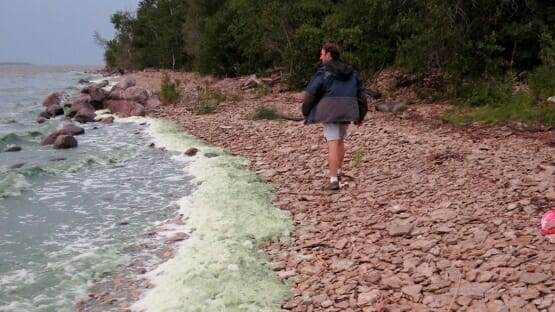Photo: Excessive nitrate in lakes, seas and rivers can increase algae growth that can lead to toxic blue-green blooms. The IAEA, in collaboration with the University of Massachusetts, has developed an innovative method to trace the origin of nitrate pollution in water. (Photo: L. Wassenaar, IAEA)
The International Atomic Energy Agency (IAEA), in collaboration with the University of Massachusetts, has developed an innovative method for tracing the origin of nitrogen pollution in lakes, seas and rivers. The nuclear-derived analytical tool provides a cheaper, safer and faster way to determine if excessive nitrogen compounds in water stem from agriculture, sewage systems or industry, helping prevention and remediation efforts.
Nitrogen, an essential and abundant element on earth, is a key fertilizer widely used in agriculture since the mid-1900s. “One of the major global problems in terms of water quality is that we have been overfertilizing our landscapes for decades, either with manure or synthetic fertilizers,” said Leonard Wassenaar, head of the IAEA Isotope Hydrology Section at the IAEA. “All of these nutrients, particularly nitrogen forms such as nitrates, are seeping into groundwater and eventually into rivers, lakes and streams.”
The excessive nitrate levels increase algae growth that can lead to toxic blooms. These also sink to the bottom of lakes, feeding bacteria and creating so-called ‘dead zones’. “We now see more fish kills, where thousands of fish float to the surface because the bottom of the lake where they normally dwell is depleted of oxygen from this rain of organic material,” Wassenaar said.
Removing nitrates from water is very difficult and expensive so tools are needed to understand nitrogen sources and pathways to better inform water protection and remediation efforts.
The new method, presented at last week’s IAEA’s International Symposium on Isotope Hydrology, and published in the international journal Rapid Communications in Mass Spectrometry, measures the amount and proportion of nitrate stable isotopes in water. Nitrogen has two stable isotopes, or variations of its atoms, with different weights. Since the weight difference is not the same in human waste or fertilizers, for example, the isotopes can be used to identify the source.
“Isotope tools are very powerful to measure nutrients in water,” said Wassenaar, “but historically their use has been very difficult, hampered by cost and accessibility. The new technique allows scientists to run more samples, and much more cheaply for large scale studies. I think it is a game changer.”
The new method uses a form of titanium chloride – a salt – to convert nitrate in a water sample to nitrous oxide gas. From this gas, the isotopes can be analyzed with equipment such as […]
Full article: IAEA Develops New Method to Track Sources of Water Pollution
More about nitrogen in public waterways and water supplies:
Long term ag change impacts stream water quality
In the Heart of the Corn Belt, an Uphill Battle for Clean Water
Fireworks at Mt. Rushmore contaminated water supply
Simple River-Cleaning Tactics That Big Farms Ignore
Nitrates stored in rocks ‘nail in coffin’ for artificial fertilizers


